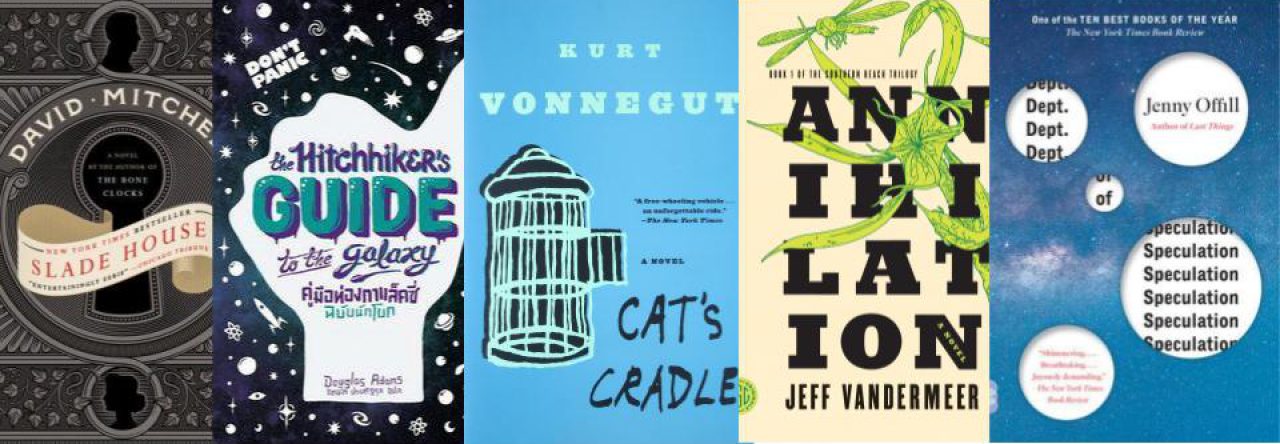Vonnegut, Kurt. Cat’s Cradle. Alberta Education, Learning Resources Centre, Specialized
Services for Students With Visual Impairment, 2013.
Reading For Mimesis and Theme
Cat’s Cradle by Kurt Vonnegut is a difficult book to explain to a person who hasn’t read it. There are so many turns and seemingly irrational plot points and deeply hidden themes that the whole story itself could be portrayed as a physical cat’s c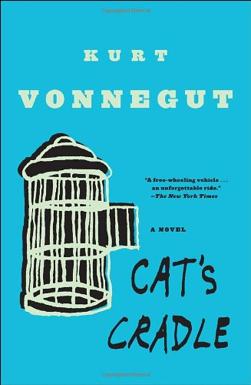 radle.
radle.
What I can say is that the book follows a man who likes to call himself Jonah (whose original name was John). He tells us his failed attempt at writing an account about what important Americans were doing when the bomb was dropped on Hiroshima, Japan. We see him gather information from various eccentric characters, all interlocked with one another. And while all this is happening, Jonah is explaining how he was led to becoming a devout member of a religion known as Bokononism, in which all things that are told as truths are actually shameless lies.
So what could this all mean?
This was difficult for me to come up with because the story is “all over the place”.
 But then again, this is what I am reading for. I knew what I was getting myself into when I chose this book. I had already read Kurt Vonnegut’s Slaughterhouse-Five, so I expected this story to be satirical and confusing. And those expectations have been met so far. It only raises my curiosity, and I am intrigued in learning about the meaning of Cat’s Cradle’s Story.
But then again, this is what I am reading for. I knew what I was getting myself into when I chose this book. I had already read Kurt Vonnegut’s Slaughterhouse-Five, so I expected this story to be satirical and confusing. And those expectations have been met so far. It only raises my curiosity, and I am intrigued in learning about the meaning of Cat’s Cradle’s Story.
I decided to refer to the writings of Robert McKee, a writing expert we have read about a lot in class. One quote really stuck out to me-“A well-told story neither expresses the clockwork reasonings of a thesis nor vents raging inchoate emotions. It triumphs. In the marriage of the rational with the irrational.”
The best way to find the rational in the irrational is to come up with a network of controlling values.
In every story, there is a controlling idea- the idea that is the most prominent. Every controlling idea has two parts- purpose and context. The purpose is the reasoning for the controlling idea, and the context is the reasoning for the purpose. For every controlling idea, there is a counter controlling idea, which is the former’s complete opposite. The counter idea has its own purpose and context that help to have it make sense and be understandable.
Here’s a visual example of a network of controlling values for The Matrix:
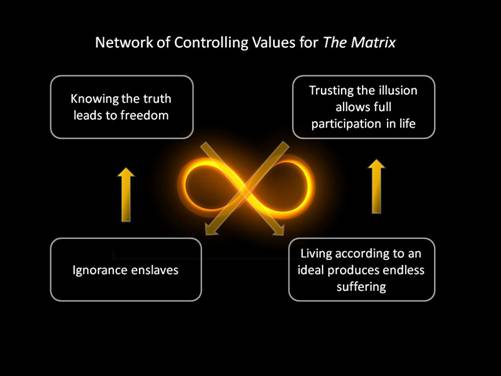
So, this is one network my group came up with from the first thirty-five chapters of Cat’s Cradle:
By questioning everything, you may discover your own truths; not questioning anything will lead to ignorance and believing lies. However, being ignorant can save you from discovering hard truths; looking for truth will lead you to uncover things that will be hard to deal with.
To highlight this network, I wanted to focus on this one situation from the book, when Jonah asked Marvin Breed, the owner of Avram Breed and Sons, a tombstone establishment, who paid for a particular tombstone with an angel on it. ( 72-73)
“There’s already a name on it- on the pedestal.”
“It was never called for?” I wanted to know.
“It was never paid for…. This German immigrant…his wife…died of smallpox here in Ilium. So he ordered this angel to be put up over her…..”
“But he never came back?” I asked.
“Nope.” Marvin Breed nudged some boughs aside…There was a last name written there. “There’s a screwy name for you,” he said. “If that immigrant had any descendants, I expect they Americanized the name. They’re probably Jones or Black or Thompson now.”
“There you’re wrong,” I murmured.
…….
“You know some people by that name?”
“Yes.”
The name was my last name,too.
Purpose- By questioning everything, you may discover your own truths.
Jonah, in the pursuit of finding out who had ordered the tombstone, discovered that it was his own last name written on it. This may mean that his story was always meant to be intertwined with the Hoenikker family. The German Immigrant (who may be Jonah’s ancestor), bought the tombstone from Marvin Breed’s great-grandfather. Marvin Breed is the brother of Doctor Asa Breed, who loved Emily Hoenikker, the deceased matriarch of the family Jonah is learning about. Maybe it was his destiny to go interview them?
Anyways, the Immigrant couldn’t pay, but said that he would be back to pay for it and pick it up when he could. He never came back, and wasn’t part of any conversations until Jonah arrived (maybe saying that he is the descendent meant to return to pick up the tombstone).
Interestingly enough, Jonah Experienced his first vin-dit around this time, a Bokononist word meaning a “sudden, very personal shove in the direction of Bokononism, in the direction of believing that God Almighty” has some elaborate plans for him. Again, this hints that Jonah was always destined to go to the town of Iliad to meet with the Hoenikker children. Jonah says early in the book that those three children were surely included in his Karass, which Bokononists believe is a team that does God’s Will without ever discovering what it is doing.
Context- Not questioning anything leads to ignorance and believing lies.
If Jonah had never questioned Marvin Breed about the Immigrant and the tombstone, he would have just assumed that it was a personal tombstone for the Breeds themselves (which is why they refuse to sell it). He would have been ignorant to the fact that he had a possible connection with the Hoenikker family. He would have never experienced his first vin-dit, which had lead him to the path of becoming a full-on Bokononist. If he wasn’t into the religion, his whole story which he is telling us, would have played out, and been interpreted completely differently. Maybe all the events that he tells us about won’t be shameless lies anymore. Maybe we could have learned the real truth.
Purpose- Being ignorant can save you from uncovering hard truths.
If Jonah had chosen not to ask questions (which wouldn’t make sense since he is interviewing people for his book), he wouldn’t have learned that he was personally tied to the story of the Hoenikkers (meaning that he could keep himself at a comfortable space from them; he doesn’t have to worry much about them).
If he had chosen not to ask questions, Jonah would not have been thrust into Bokononism, radically altering how he views life, and getting rid of his Christian faith.
Context- In the pursuit of discovering truth you may uncover things that are hard to deal with.
Whether he liked it or not, Jonah, through asking the questions, had to deal with the fact that he was connected to the Hoenikker family. He might not enjoy their presence, but he will still be drawn to them.
And when the actual vin-dit happens, it wasn’t exactly pleasant for Jonah:
“There you’re wrong,” I murmured.
The room seemed to tip, and its walls and ceiling and floor were transformed momentarily into the mouth of many tunnels- tunnels leading in all directions through time. I had a Bokononist vision of the unity in every second of all time and all wandering mankind, all wandering womankind, all wandering children.
“There you’re wrong,” I said when the vision was gone.
The experience shakes him, and he can barely speak after it. Learning this possible truth was a bombshell for Jonah.
Here is a value graph– a way to show the battle between the controlling idea (+) and the counter controlling idea (-) in a specific scene ( 23):
Every class, he explained, got to pick distinctive colors colors for itself in its junior year, and then it got to wear those colors with pride.
(+) “What colors did you pick?” I asked. Jonah is questioning this hoping to find out some valuable information about Franklin Hoenikker, the second of the three children.
“Orange and black.” This is a straight answer that won’t change the graph.
(+) “Those are good colors.” The original controlling idea is still ruling; this is Jonah seeing how the bartender will respond.
“ I thought so.” I don’t see this affecting the graph.
(+) “ Was Franklin Hoenikker on the Class Council Committee, too?”
(-) “He wasn’t on anything,” said Sandra scornfully.
(-) “He never got on any committee, never played any game, never took any girl out. I don’t think he even talked to a girl. We used to call him Secret Agent X-9.” Sandra believes this and is ignorant of Franklin true self. She only knows him through what was observed/rumored of him. The graph is doing a major descent.
(+) “X-9?” Small positive.
(-) “You know-he was always acting like he was on his way between two secret places; couldn’t ever talk to anybody.” Minor descent because Sandra is not giving much thought on the matter.
(+) “ Maybe he really did have a very rich secret life,” I suggested. Rising, because this curiosity will eventually lead to truth.
(-) “Nah.” Descending again.
(-) “Nah,” sneered the bartender. “He was just one of those kids who made model airplanes and jerked off all the time.” Not even considering Jonah’s words. Sharp descent.
At the end of this scene, the counter controlling value-being ignorant can save you from discovering hard truths and looking for truth will lead you to uncover things that will be hard to deal with-won out.
In my experience, there have been a few times where the initial network evolved into something different over the course of the narrative. For example, one of my fellow group members came up with a different network that works as well:
I thought maybe to up the ante of the context, we could add the “ouch factor” he mentioned.
Ie. Not questioning anything leads to ignorance and living other’s dreams.
Purpose:
Ie. By questioning everything you may discover your own truths and live the life you want.
Our professor suggested this idea of science vs. myth which in my opinion heavily aligns with our text. Discussing both Dr. Hoenikker as a scientist and religion in the form of Bokononism was a carefully crafted plan of the author to further sell the opposing values.
On page 5 Jonah quotes the book of Bokonon:
“All of the things I am about to tell you are shameless lies.”
This sentence alone does a great job of pulling the readers into the book’s network of controlling values. It forces the readers to constantly question if everything they come across in the book is true or not. We are then thrusted out of our comfort zone and forced to either submit to the text and believe everything it says or be skeptical and question everything.
In the end, just keep some kind of a network in the front of your mind as you read, “plugging in” story beats to see if it still works. Story-wise, I think Jonah will continue to ask questions and experience vin-dits, finding out more about his connection to this whole narrative.
Reading For Form and Genre
Cat’s Cradle proves to be an extremely complex work of fiction that manages to shed light on real, relevant social issues in a way that is entertaining, and even humorous to the reader, despite the issues that are brought to light being potentially uncomfortable to think about.
While it can be argued that Cat’s Cradle falls into several different genres, due to both its unique style and execution, the aforementioned characteristic primarily points towards the genre and conventions of satire.
Satire exists for this very reason, to use humor and entertainment to either insight some sort of change, or at least bring the audience to further think about and investigate societal issues that might otherwise go unattended to.
As you should recall, one of the primary sets of controlling values that was identified was the idea of either seeking the truth at the risk of one’s own happiness and/or comfort, and living in the comfort of a lie while accepting that it is in fact a lie– which speaks as to why this genre needs to exist in the first place. Many people may be tempted to ignore issues for the sake of complacency and comfort, but satire serves as a way to effectively trick this target demographic to see through to the other side, and perhaps allow them to see the truth without sacrificing their comfort or happiness.
Aside from this element of satire, Cat’s Cradle relies heavily on the conventions of science fiction, such as a futuristic setting relative to the time period the book was produced, and the invention of new technologies, lexicon, and organizations. Science fiction is a genre that combines extremely well with the elements of satire for the very reason that science fiction exists in the first place, exploring “what if” scenarios and satisfying the innate human element of curiosity/innovation.
The conventions of both satire and science fiction is one form used in Cat’s Cradle, but another form found in the book is the qualitative progressive form. As Burke discusses in his Lexicon Rhetorica, qualitative progressive form is “the presence of one quality prepares us for the introduction of another” (125).
One example would be foreshadowing, but the form calls for more than one insistence. In Cat’s Cradle, Jonah sets up a qualitative progressive form when he introduces us to the idea of his karass. Jonah tells the reader that his karass “includes the three children of Dr. Felix Hoenikker” (6). By doing so, Jonah is establishing a mood of anticipation. The reader knows that Jonah will be tangled up with the Hoenikker children (Newt, Angela, and Frank) and they are constantly waiting for the moment where the convergence of these characters finally happen. Jonah repeatedly has close, but not full, encounters with the Hoenikker children, like Newt writing Jonah a letter or people in Ilium talking about them, which build the anticipation.
Then finally when they meet on a plane ride by chance, Jonah goes to talk to them, and the reader feels a sense of completion or satisfaction. That mood would not be possible if the reader had not been placed in a state of anticipation before. Newt even happens to be drinking champagne, making the meeting feel like a celebration.
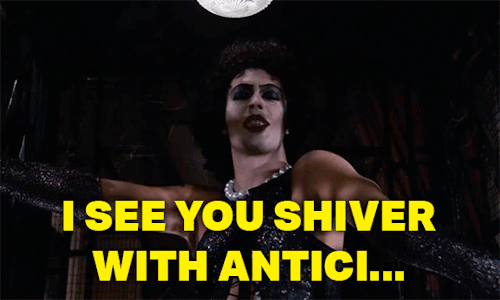
But then, Jonah says “The little son of a bitch had a crystal of ice-nine in a thermos in his luggage” (111). Oh yeah, nothing is actually resolved because world ending ice-nine substance Jonah also warned us about is still out in the world, which Jonah on the plane doesn’t know about, and the karass hasn’t actually done anything they are suppose to. So in a sentence the reader gone from that fleeting sense of resolution back to anticipation.
The qualitative progressive form created by the repeated idea of the karass takes the reader through the spectrum of anticipation and resolution. But there is another spectrum created of being given answers and then asking questions. For example, Jonah gives us an answer in the previous quote, “The little son of a bitch had a crystal of ice-nine in a thermos in his luggage.” Repeatedly Jonah tells the reader that the Hoenikker children have ice-nine. The answer to the mystery of where is Dr. Hoenikker deadliest weapon is already given to us, but because the answer leads the reader to ask more questions. What are the Hoenikkers going to do with it? How will Jonah discover they have it? Will someone release it upon the world? The qualitative progressive form is taking the reader along the spectrum that the genre of satire wants the reader to take–to question. Satire wants to make us think, often about issues that we do not wish to. By giving the reader some of the answers, the qualitative progressive form in Cat’s Cradle is preparing the reader to ask the questions they might not have wanted to ask.
While the narrator is searching for his own truth, so is the reader. In this way, the narrator is almost meant to be a stand-in for the average reader, or target demographic for which the form is directed at. Not only does this make the narrator immediately relatable in an emotional sense for the reader, but it also means that the reader is inherently thrown into the struggle between the opposing controlling values along with the narrator.
Considering the discussed intention of satire, to introduce potentially unsuspecting readers to potentially uncomfortable ideas or situations in the hopes of inciting some sort of cultural change or recognition of an issue, this means that the form serves to accomplish the goal of the genre and specific novel very well. One of my fellow group members also had interesting thoughts about this:
It is common in our culture today to dismiss things that is different than the norm, as odd or unusual without giving it much thought. Instead of taking the time to question things, it is easier to react by labeling it weird and moving on. This is portrayed in the text when Jonah is touring Dr.Honikker’s office with Miss Faust. They see the room is a mess scattered with ten cent toys that he used for his experiments and unopened letters on his desk. Jonah notices a framed photograph on the desk and asks if it was a picture of his wife or his children. He responds in that way because having a picture of your family on your desk is something that is also common in our culture today. Instead we as readers are shocked to discover that the photograph does not include his family or himself but a war memorial.
“That was one of his hobbies,” said Miss Faust.(57)
“What was?”
“Photographing how cannonballs are stacked on different courthouse lawns. Apparently, how they’ve got them stacked in that picture is very unusual.”
“I see.”
“He was an unusual man.”
We see that Miss Faust is able to dismiss Dr. H. was an unusual man and not give it any other thought. This aligns with the network of controlling values that we came up with for this book in class. (context: Not questioning anything leads to ignorance and believing lies.) I think that Vonnegut included this characteristic into the text to make the reader reanalyze their own responses to odd situations. It makes you wonder how many times you brush things off without dealing with them. Her nonchalant attitude towards the Dr. H’s corky ways is a way that many of us would respond to an unfamiliar situation. Even if we would not respond in this way, it is still realistic enough that we could step into that role and play the part. It creates for us the context to evaluate the ways in which we react to things around us and maybe change our reactions in the future.
Reading For Intertextuality
Cat’s Cradle by Kurt Vonnegut can also be taken as an exaggerated tale about religion and the culture that surrounds it. As you know, the story is told through the lense of a born again Bokononist,and follows a convoluted spiral to the end of days, so to speak. The book left me scratching my head thinking why.

Barthes argues that there are five codes that describe the intertextuality of a writerly text. The codes help the reader to understand the interruptions they may have missed upon a mimetic, linear reading. By stopping and revisiting Cat’s Cradle in segments, the writerly text, and the use of the codes, allows readers to find connections to the cultural frame the text exists in. The codes that I think work well with Cat’s Cradle are the Semic Code, the Proairetic Code, Symbolic Code, and the Cultural Code.
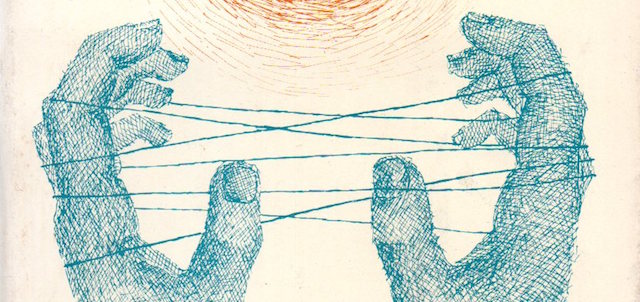
The Semic code is described as defining “characters, objects, and places through repetitively grouping a number of signifiers (“semes”: words and phrases) around a proper name.”(Kopp)
Bokonon, the creator of the religion, has multiple semes associated with him:
-Bokonon writes (2),
-Bokonon invites us ( 3, 92)
Bokonon doesn’t have any type of epithet like, “The Great” or “The Wise”, so the book doesn’t imply that he is a great person. All that he says are lies. But having words like “writes” and “invites” gives the idea that Bokonon is still a leader, someone that people listen to. The way that Jonah writes about him, it’s almost like Bokonon is a cult leader. What he says is not true, but people still choose to follow what he says.
My fellow group members, ever full of ideas, provided this about the Proairetic code :
This code is responsible for the cause and effect sequence of the narrative that assists the readers to predict what will happen next. On P.146, we see that “Papa” collapses on stage during the “welcoming” of Jonah and the other guests. He begins mouthing a few words to Frank, but it is not until someone puts a microphone to his lips, that we can understand what he is saying.
“ You,” he said to Frank hoarsely, “you- Franklin Hoenikker- you will be the next president of San Lorenzo. Science- you have science. Science is the strongest thing there is.”
Then, on P.161 Frank calls Jonah at the hotel he is staying at and sounds breathless and scared.
“Listen! You’ve got to come out to my house right away. We’ve got to have a talk! It could be a very important thing in your life!”
In the pages that follow we see that Frank does not show up to the house until later that night. The suspense of wondering what Frank wants to tell Jonah not only intensifies for Jonah himself, but us as the reader. However, we are able to predict that Frank may be asking Jonah to become the next president. Numerous times throughout the text, we are reminded that Frank was considered to be a bit odd and not great with others. ie.. on page 123,
“You know – he was always acting like he was on his way between two secret places; couldn’t ever talk to anybody.”
“Maybe he really did have a very rich secret life,” I suggested.
“Nah.”
“Nah,” sneered the bartender. “He was just one of those kids who made model airplanes and jerked off all the time.”
And again on P. 194 (right before Frank asks Jonah to be president).
About this Franklin Hoenikker- the pinch-faced child spoke with timbre and conviction of a kazoo. I had heard it said in the Army that such and such a man spoke like a man with a paper rectum. Such a man was General Hoenikker. Poor Frank had had almost no experience in talking to anyone, having spent a furtive childhood as Secret Agent X-9.”
The island of San Lorenzo also acts as a contained Symbolic Code, which Generates antitheses that structure a given conflict, and reinforces the dominant cultural codes of the time. One of the main ones being the fight between science and religion, or some form of truth and lies. There are poor islanders, cruel and rich rulers, and an oppositional religion that everyone believes in (but openly denounces). These many cultural dynamics are as old as people, and are as important today as they were when the book was written. The beauty of Cat’s Cradle is that it is self-conscious and draws attention to its Symbolic Codes. Even the cruel leader “Papa” is a devout Bokononist, demanding on his deathbed to be given last rites; “I am a member of the Bokononist faith,” “Papa” wheezed. “Get out, you stinking Christian” (218).
This comes right after “Papa” demands that Jonah kill Bokonon saying, “He teaches the people lies and lies and lies” ( 218). Having read Philip Castle’s book about San Lorenzo, Jonah knows that the Bokonon religion is built on lies and opposition between the city and the jungle. Yet still Jonah says, “I was not eager to kill anyone” (218). This symbolic code between the oppressive government and something to believe in is what kept the San Lorenzo people going. Their secret belief in Bokononism made life on the terrible island tolerable. Bokonon continually preached; “‘Live by the foma that makes you brave and kind and healthy and happy.’ The Books of Bokonon. I: 5” (epigraph).
Yet in the end, these foma (harmless untruths) lead the survivors on San Lorenzo to commit suicide. How can the foma then be harmless? How can committing suicide make “you brave and kind and healthy and happy”? I feel that the lies of Bokononism had become dangerous by this point. They no longer served their purpose in creating a utopia as I thought Johnson and McCabe had desired.
The use of religion to create happiness in this text bothers me. Instead of actually increasing the standard of living on San Lorenzo, Bokonon created a religion to relieve the people of their suffering. Yet they still suffered, and in a negative turn of e vents some even died on the hook for their beliefs. Vonnegut laid bare centuries of turmoil due to poor living conditions and mixed religious teachings in such a way that it was comical, and outrageous. He wrote the symbolic code as if he was explaining it to the reader, rather than only existing within it. He called attention to the frame his narrative lived in, creating an interruption to the mimetic experience of the readerly text, yet somehow still creating a mimetic experience. By creating a false religion that was aware of its lies, the reader is forced to look at their own religion (which is taught as truth) and question how truthful it really is.
vents some even died on the hook for their beliefs. Vonnegut laid bare centuries of turmoil due to poor living conditions and mixed religious teachings in such a way that it was comical, and outrageous. He wrote the symbolic code as if he was explaining it to the reader, rather than only existing within it. He called attention to the frame his narrative lived in, creating an interruption to the mimetic experience of the readerly text, yet somehow still creating a mimetic experience. By creating a false religion that was aware of its lies, the reader is forced to look at their own religion (which is taught as truth) and question how truthful it really is.
I think, like Campbell’s argument in Impacts of Science on Myth, the literal interpretation of Bokononism gets in the way of the spiritual impact it can have on people.
In the end the dominant cultural code, which speaks the familiar “truths” of the existing cultural order, prevails. People have died for both science and religion and will continue to do so until ice-nine destroys the world, and in most cases even after that too. In the end religion killed the people and science killed the world. What is left for us to believe in?
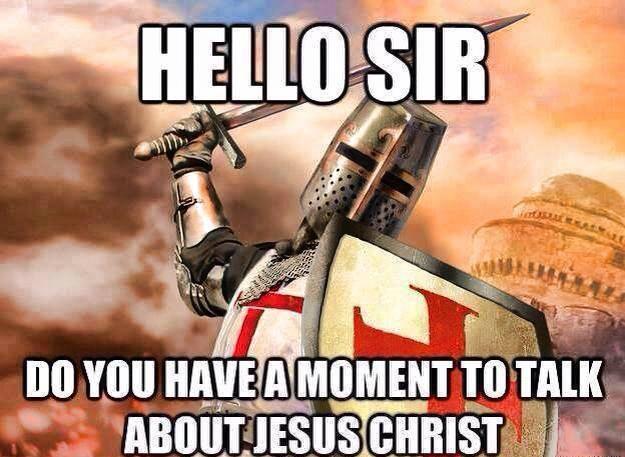
Reading For The Rhetorical Dimension of Narrative
As a reader of Cat’s Cradle by Kurt Vonnegut we are interpellated, or asked to play a certain readerly role before the story even begins. The prologue craftily welcomes us with the statement, “Nothing in this book is true.” This challenges its readers to decide whether they will in fact leave their beliefs behind and submit to the text, living by the foma.

On page 1, we are introduced to the narrator who invites his readers to call him Jonah although his birth name is John. My belief is that he is referred to as Jonah modeled after the Prophet who is sent by God to prophesy the destruction of Nineveh. In a way, Jonah is beckoning his audience to heed his warning in questioning their beliefs before it is too late. If the reader chooses to believe him, they will survive and have life through him.
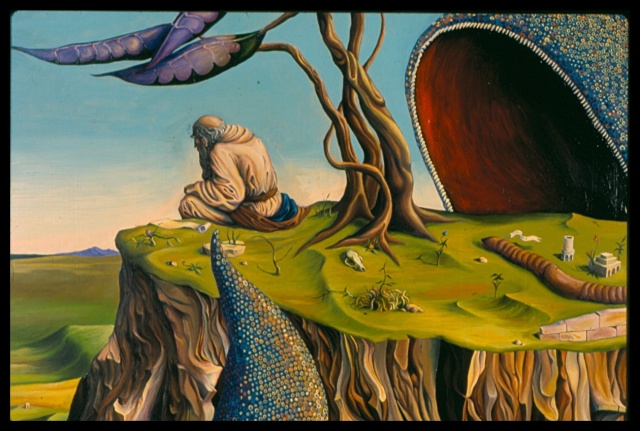
According to James Seitz, we must “attend to the relationships that readers create between themselves and the emerging possibilities which they anticipate in the text” (148). In other words, in order to understand the rhetorical dimensions of the text we must predict the ways in which an addressee may react to the text. By examining the rhetorical dimension, we see that Jonah as the narrator is specifically addressing someone.
Who could this addressee be?
By presenting the book as lies, we know that the addressee is encouraged to question everything that is presented. Which heavily aligns with the network of controlling values I came up with earlier:
By questioning everything, you may discover your own truths; not questioning anything will lead to ignorance and believing lies. However, being ignorant can save you from discovering hard truths; looking for truth will lead you to uncover things that will be hard to deal with.
Numerous times throughout the text we are introduced to characters who go about life without questioning things. For instance, on Page 25, Jonah, the bartender, and a young woman named Sandra are discussing how Dr. Hoenikker was the guest speaker at her commencement.
He said science was going to discover the basic secret of life someday,” the bartender put in. He scratched his head and frowned. The conversation continues with the bartender stating that he read in the paper that scientists had finally worked out the answer.
“I missed that,” I murmured.
“I saw that,” said Sandra. “About two days ago.”
“That’s right,” said the bartender.
“What is the secret of life?” I asked.
“I forget,” said Sandra.
“Protein,” the bartender declared. “They found out something about protein.”
“Yeah.” said Sandra, “That’s it.”
The bartender and Sandra do not seem to question this answer even though it seems very odd. What about protein could make it the basic secret of life? If it is the great truth, then what does it mean? This reaction is making a statement about how many times we are told things in life, especially from those who hold the position of power, and we just accept them as the truth.

The addressee that Jonah is addressing is the reader who believes everything they are told to be the truth. The narrator is almost reminding the addressee to live life for the chase of the answer and not finding the answer itself. If the answer to the great truth was truly revealed, then the search for the answer would end. Just as my group leader Laura points out that “the ruler of San Lorenzo can never get Bokonon because that would end the hunt for Bokonon.”
As a reader being introduced to this new type of religion that is based on lies, our typical way of thinking gets disturbed. This new way of thinking forces us to question everything that we are told and not just accept the account as the truth.
For example, the narrator/addresse situation could be approached differently.
Cat’s Cradle is Jonah’s now completed book The Day the World Ended. We are led to believe that it is about the people involved in the Hiroshima bombing, but through Jonah’s quest to collect info, he is actually telling us the true story of how the world actually ended.
Bokononism has a big part to play in the story, as a lot of the characters believe in it, and Jonah himself eventually takes it up. He mentions that the book was “to be factual”. As we know, Bokononism is built on lies. I think this is a hint that the event is not entirely true, and is just a way to explain how the world has ended.
Maybe Jonah is writing the book long after the events of it take place, and that he is a full on Bokononist. That’s why he says he was a much younger man when he began collecting materials for the book- it was chronologically earlier, and he was young in the ways of Bokonon.
Since the world ended, there is probably only one copy of Jonah’s now complete book. I think the addressee, as Jonah would like it to be, is someone who finds the book and is interested in learning how the world ends. Since it is not factual, they might not learn what really happen, but the novel will be a gateway to Bokononism. Maybe the book is actually a way to convert people to the religion through a not entirely factual account of the end of the world.
By witnessing the interaction between the narrator and addressee unfolding in front of you, you realize how believing a harmless lie could be more beneficial than facing the hard truths.
Final Reflection
Critically reading complex and sophisticated texts like Cat’s Cradle has helped me grow as a reader and writer. I find that my experience mirrors one of my class’ core values (overall goals that should be met)- Core Value 3: Writing Arts students will demonstrate the ability to critically read complex and sophisticated texts in a variety of subjects. This annotated bibliography shows my progression and growth in thought process as I read and broke down the novel.
One of Core Value 3’s outcomes that I think really resonates with this piece is:
Students will notice and question the limits imposed by their initial point of view when approaching a given text, allowing them to think through the moving parts of a text, to understand and articulate the purpose behind its design, the targeted audience, and the context the text responds to.
I already knew that Kurt Vonnegut could create complex stories, having read Slaughterhouse-Five when I was in High School. But when I picked up my copy of Cat’s Cradle, I couldn’t see it as more than a light satire. The novel’s description is this:
An apocalyptic tale of this planet’s ultimate fate, it features a midget as the protagonist; a complete, original theology created by a calypso singer; and a vision of the future that is at once blackly fatalistic and hilariously funny.
It’s completely zany and looks like it makes no sense! How could this book be so complex? Just flipping through the first pages I was amazed at how simple the text was. My copy of the novel featured a large font (reminiscent of a kid’s novel), and chapters that only lasted one to two pages!
I will admit, this is why I chose to have my group read this novel- I thought it would be a breeze to read. It would have been a nice and enjoyable time, where there wouldn’t be much need for analyzation.
As I am sure you are aware after having read the rest of this annotated bibliography, Cat’s Cradle is super complex.
However, as you may not know, this annotated bibliography started out as four different blogs (which can be found here), each one meant to analyze a specific part of the novel (they each ended up as the basis for the different sections of this piece). It was going through each of these blogs that my perspective on the book changed, while also expanding my knowledge as a reader and writer.
From the get go, writing the first blog taught me about what a network of controlling values is, and how it is present in nearly any narrative. I remember thinking, “so, how the hell do I come up with a network for this book?”
With the help of fellow group members, of course. We looked at the situations in the novel, and listened to what Jonah was telling us. We came up with this:
By questioning everything, you may discover your own truths; not questioning anything will lead to ignorance and believing lies. However, being ignorant can save you from discovering hard truths; looking for truth will lead you to uncover things that will be hard to deal with.
I couldn’t believe that these deep and thought-provoking themes came out of a zany novel like Cat’s Cradle. But the value graph showed that they were very much present in the narrative, even in the most outlandish of scenes.
The second blog introduced me to the concepts of form and genre. I didn’t know what form was, and I thought genre was how the story was classified.
I learned about the five different aspects of form– conventional form, syllogistic progressive form, qualitative progressive form, repetitive form, and minor/incidental forms, and after some thought, was able to relate some of them to the novel (as seen in the second section). With these forms, I was able to break down the genre of satire, and really look into its conventions.
What else could be looked at? I remember sitting cluelessly when hearing that I’d have to search for intertextual codes in my third blog. So now, books have codes?!
Yes they do, and the five that I looked into were the semic, hermeneutic, proairetic, symbolic, and cultural codes. And to my surprise, four of these popped into my mind in relation to the novel (as seen in the third section).
So, after this little journey of surprise and enlightenment, it was time for me to work on the final blog, which dealt with the narrator and addressee. Again, my presumptuous self couldn’t understand how this aspect could be so complex. The first line of the novel literally tells you that Jonah is the narrator! Whoever is reading the novel is the addressee. Simple.
But, as my group members came to tell me, there needed to be more thought put into the matter. Why is Jonah writing to us? What is he writing in? When is he writing the story? Is any of it true? Who is Jonah intending the addressee to be? Where would the addressee find the story? What will the addressee do about the novel?
There are so many questions, and so many routes that can be taken. Just thinking about this blows my mind. Cat’s Cradle, just like the game the title is modeled after, is a maze of possibilities.
Practicing these various rhetorical aspects in my blogs (and cleaned up in my annotated bibliography) has taught me so much about the construction of a novel, and what a writer can do to provide a multi-layered experience for the reader.
And Cat’s Cradle is now another one of Kurt Vonnegut’s stories that I love. The hidden complexity of the novel, paired with the seemingly simple narrative gave me an experience that I had never went through before, permanently altering my perspective on the novel, while also broadening what I thought was possible as a reader and writer.
